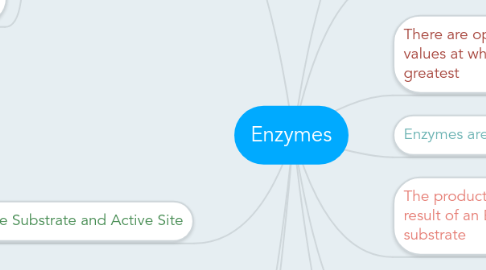Enzymes
создатель Amy Gordon

1. Enzyme Reactions
1.1. Digestive Enzymes
1.1.1. Lipase - breaks down fats into fatty acids and glycerol
1.1.1.1. Fats --lipase--> Fatty Acids + Glycerol
1.1.2. Amylase - breaks down starch into sugars
1.1.2.1. Starch --amylase--> Maltose
1.1.3. Pepsin - breaks down protein into polypeptides
1.1.3.1. Protein --pepsin--> Peptides
1.2. Glucose-1-Phosphate --phosphorylase--> Starch
1.3. Hydrogen Peroxide --catalase--> Water + Oxygen
2. The Substrate and Active Site
2.1. Enzymes are proteins folded into complex shapes that allow smaller molecules to fit into them
2.1.1. The place where these substrate molecules fit is called the active site
2.2. The enzyme's active site is complementary to the substrate
2.3. Only one substrate can fit into the enzyme's active site
2.4. Both structures have a unique shape
2.5. If the shape of the enzyme changes, its active site may no longer work
3. Intracellular enzymes are found within the cell
4. Extracellular enzymes act outside the cell e.g. digestive enzymes
5. If the temperature is too high or there is an extreme pH level, the Enzyme becomes denatured
6. Enzymes are biological catalysts
6.1. Catalysts are substances that speed up chemical reactions without being used up
7. There are optimum temperatures and pH values at which the Enzyme's activity is greatest
8. Enzymes are globular proteins
9. The product is the substance formed as a result of an Enzyme acting on its substrate
10. An Enzyme is a protein made by living cells that acts as a biological catalyst
11. Synthesis is the building up of large complex molecules from simpler ones by an Enzyme - it is a controlled reaction


